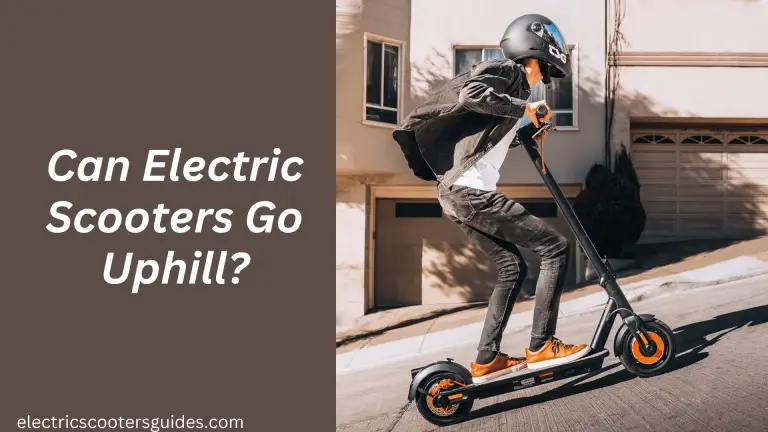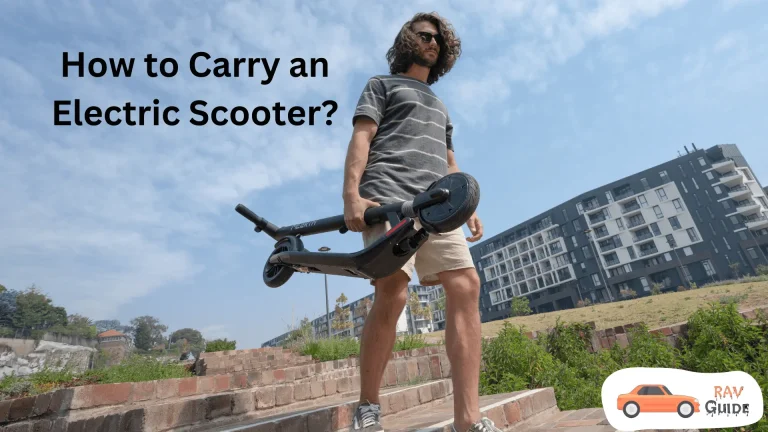Electric Scooter Safety Guide

As electric scooters continue to surge in popularity as a convenient and eco-friendly mode of transportation, it’s essential to prioritize safety to ensure enjoyable rides for both riders and pedestrians alike. Whether you’re a beginner or a seasoned scooter enthusiast, this guide is designed to equip you with the knowledge and tips necessary to navigate urban landscapes responsibly, minimize risks, and maximize your enjoyment of this exciting form of travel. In this guide, we will discuss about electric scooter safety guide.
Are Electric Scooters Safe?
Electric scooters are a fun and convenient way to get around, but are they safe? Well, let’s look at the facts. Studies from organizations like Consumer Reports have gathered data on scooter accidents, and what they found might surprise you. It turns out, many accidents happen because riders aren’t wearing helmets or aren’t experienced enough. In fact, about a third of head injuries occur because riders don’t wear helmets. And get this – most accidents aren’t even caused by crashes, but by riders simply losing their balance and falling off!
One big reason for these accidents is the way people approach riding scooters. Some folks treat them like toys instead of vehicles. But just like we teach kids to ride bikes safely, we need to take electric scooters seriously too. That means wearing helmets, paying attention to the road, and being aware of potential dangers like potholes or slippery surfaces.
Riding an electric scooter is different from riding a bike. The smaller wheels can be tricky, especially on uneven roads. And when it’s wet outside, braking takes longer and it’s easier to skid. That’s why it’s crucial to stay focused and always be prepared for the unexpected. Remember, not everyone on the road may see or hear you as well as you think.
So, are electric scooters safe? They can be, as long as we ride them responsibly and take safety precautions seriously. So, before you hop on your scooter, make sure you’ve got your helmet on and your wits about you.
Tips to Ride Electric Scooters Safely
Inspect the Scooter Before your Ride
Inspecting your scooter before each ride is essential for your safety and the longevity of your ride. Here’s a simple checklist to follow:
- Tire Check: Make sure your scooter’s tires are properly inflated and free of any damage like cuts or punctures. Properly inflated tires ensure better traction and stability while riding.
- Brake Test: Test your scooter’s brakes to ensure they are working correctly. Give them a gentle squeeze to ensure they engage smoothly and bring the scooter to a stop without any issues.
- Handlebar Alignment: Check that the handlebars are properly aligned and secure. Any looseness or misalignment could affect your control over the scooter while riding.
- Battery Level: Check the battery level indicator to ensure you have enough charge for your intended ride. Running out of battery power mid-ride can be inconvenient and potentially unsafe, especially if you’re far from home.
- Lights and Signals: Test the scooter’s lights and signals to ensure they are functioning properly. This includes headlights, taillights, and turn signals if your scooter is equipped with them. Proper lighting is crucial for visibility, especially when riding in low-light conditions or at night.
- Frame and Body: Inspect the scooter’s frame and body for any signs of damage or wear. Look for cracks, dents, or loose parts that may need attention before riding.
- Kickstand: Ensure the kickstand is securely in place and functioning correctly. A faulty kickstand can cause your scooter to tip over when parked, leading to potential damage or injury.
Wear a Helmet
Wearing a helmet is a non-negotiable when it comes to riding an electric scooter. Your helmet is your best defense against head injuries in the event of a fall or collision. Studies have shown that wearing a helmet significantly reduces the risk of head trauma and can even save lives.
So, before you even think about hitting the road, make sure you strap on a properly fitting helmet. It’s not just about following the rules; it’s about protecting yourself and ensuring you can continue enjoying your rides safely for years to come. Don’t take chances with your safety – make wearing a helmet a habit every time you ride your electric scooter. You should also know why my electric scooter charger stays green.
Ride Solo
Riding solo is a golden rule when it comes to electric scooters – never ride tandem. While it might seem fun to share the ride with a friend, riding solo is essential for safety reasons. Electric scooters are designed and balanced to accommodate a single rider, and adding extra weight or passengers can throw off the balance and stability of the scooter.
This increases the risk of accidents, loss of control, and injury to both riders. Additionally, riding tandem can distract the driver, making it harder to focus on the road and react to potential hazards. So, always remember: one scooter, one rider. It’s the safest way to enjoy your electric scooter adventures.
Slow down Before Looking Back or Turning
Slowing down before looking back or making a turn is a crucial safety practice when riding an electric scooter. Taking these actions while still moving at high speed increases the risk of losing balance, skidding, or colliding with obstacles or other road users.
By reducing your speed before checking behind you or making a turn, you give yourself more time to assess the situation, react appropriately, and execute the maneuver safely. This simple precaution can help prevent accidents and ensure a smoother, more controlled riding experience for both you and those around you. So, remember to always slow down before looking back or making any turns while riding your electric scooter.
Don’t Use your Phone while Driving
Using your phone while driving an electric scooter is a dangerous distraction that significantly increases the risk of accidents. Whether you’re texting, making calls, or checking social media, taking your eyes and attention off the road can have serious consequences. Just like driving a car, operating an electric scooter requires full focus and awareness of your surroundings.
Even a momentary lapse in attention can result in collisions with pedestrians, other vehicles, or obstacles on the road. To prioritize safety, always keep your phone securely stowed away while riding your scooter. If you need to make a call or respond to a message, pull over to a safe location and stop your scooter before using your phone. Remember, safety should always come first when you’re out on the road.
Avoid Riding in Bad Weather Conditions
Avoiding riding in bad weather conditions is essential for your safety when using an electric scooter. Wet or icy surfaces can reduce traction, making it easier to lose control and slip. Additionally, rain, snow, or fog can impair visibility, increasing the risk of accidents with other vehicles or pedestrians. Strong winds can also destabilize your scooter, making it harder to maintain balance and control.
If the weather conditions are poor, it’s best to postpone your ride until conditions improve. However, if you must ride in inclement weather, take extra precautions. Reduce your speed, increase your following distance, and be extra vigilant for hazards on the road. Additionally, consider wearing appropriate rain gear and ensuring your scooter’s lights are working correctly to enhance visibility.
Don’t take unnecessary risks by riding in bad weather conditions if you can avoid it. Wait for better weather, and enjoy your ride safely.
Keep your Eyes on the Road
Keeping your eyes on the road is paramount for safe electric scooter riding. It’s easy to get distracted by passing scenery, other riders, or even your thoughts, but diverting your attention from the road increases the risk of accidents. By maintaining a focus on the path ahead, you can anticipate obstacles, pedestrians, and other potential hazards, allowing you to react quickly and avoid collisions.
Remember, even a split-second distraction can have serious consequences, so stay vigilant and keep your eyes on the road at all times. This simple habit can make all the difference in ensuring a safe and enjoyable ride for yourself and those around you.
Avoid Riding in Pedestrian Areas
Avoiding riding in pedestrian areas is crucial for both your safety and the safety of pedestrians. Pedestrian areas are designated for walking, jogging, and other non-motorized activities, and introducing electric scooters into these spaces can create hazards and conflicts.
When riding your electric scooter, stick to designated bike lanes, roads, or paths specifically designated for shared use by cyclists and scooters. These areas are designed to accommodate faster-moving modes of transportation safely.
If you need to traverse pedestrian areas to reach your destination, dismount from your scooter and walk it until you reach a suitable riding area. This demonstrates respect for pedestrians and helps prevent accidents or conflicts.
By avoiding riding in pedestrian areas, you contribute to a safer and more harmonious environment for everyone sharing the streets and paths. Respect the designated spaces for different modes of transportation, and prioritize safety at all times.
Follow Regular Road Safety
Following regular road safety practices is essential when riding an electric scooter to ensure your safety and the safety of others. This includes obeying traffic laws, signals, and signs, just as you would when driving a car or riding a bicycle.
Always ride in the same direction as the traffic flow and stay on the right side of the road, allowing faster-moving vehicles to pass safely. Use hand signals to indicate your intention to turn or stop, and always yield to pedestrians at crosswalks and intersections.
Be aware of your surroundings and anticipate potential hazards, such as potholes, debris, or parked cars opening their doors. Maintain a safe distance from other vehicles and pedestrians, and avoid sudden maneuvers or erratic riding behavior.
Additionally, wear reflective clothing and ensure your scooter has working lights and reflectors, especially when riding at night or in low visibility conditions.
By following regular road safety practices, you can minimize the risk of accidents and enjoy a safer and more enjoyable riding experience on your electric scooter. Remember, safety always comes first!
Conclusion
In conclusion, prioritizing safety is the key to enjoying electric scooter rides responsibly. By following the tips and guidelines outlined in this guide, you can minimize risks, prevent accidents, and ensure a smooth and enjoyable ride every time. Remember to always wear a helmet, obey traffic laws, and stay alert to your surroundings. With these safety measures in mind, you can confidently explore the city streets and make the most of your electric scooter adventures. Stay safe and happy riding!






